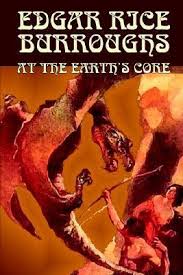Chapter VI — At the earths core
byChapter VI begins with rising dread. The captives, including the narrator, are marched from their quarters under the tight watch of Sagoths. There is no sky to mark time—only a ceaseless light, making escape nearly impossible. They are surrounded by talk of brutal consequences for escape attempts. Whispers among the slaves turn the march into something far more ominous. The guards seem more agitated, rougher than usual. When Dian is mentioned, a bolt of fear courses through the narrator. The possibility that she may be one of the condemned fuels his anxiety. He cannot ask aloud, but every step feels heavier. Hope is a dangerous burden here.
The procession ends at a massive stone arena, alien in design yet unmistakably built for violence. Rows of Mahars line the upper tiers, their wings folded tight as they prepare to witness their form of entertainment. It is not music or speech that opens the event, but a sequence of precise, hypnotic motions performed by their own—movements meant to soothe or stimulate through a language foreign to the human senses. What follows strips away any illusion of civility. Two human captives are led out, visibly trembling, and are given primitive spears. They stand at the center, vulnerable and surrounded. From opposite gates, monstrous creatures appear—first, a towering thag, its horns glinting, followed by a lithe but muscular tarag with eyes burning red. The Mahars stir, almost as if thrilled.
As the beasts circle their prey, the captives do their best to survive. The man steps in front of the woman, perhaps out of love or duty, using his spear to keep the thag at bay. The tarag waits, patient and calculating. When it finally lunges, chaos erupts. The man is thrown, bleeding, and the woman stabs desperately. In that moment, the thag charges. Instead of hitting the captives, it collides with the tarag, initiating a savage fight between the two predators. Flesh tears, bones snap, and the arena fills with the sound of violence. The humans crawl to safety amid the battle, forgotten for the moment. All eyes—Mahars and Sagoths alike—focus on the clash of titans.
The narrator watches with revulsion and awe. This display is more than bloodsport. It is a performance reinforcing the hierarchy of Pellucidar. The Mahars rule not just with intelligence, but through fear and spectacle. Humans are both audience and warning—reminded that resistance only feeds the arena. Yet, something else stirs in the narrator. The Mahars may hold power now, but they lack emotion. Their cruelty is clinical, detached. That very detachment, he thinks, could one day be their weakness.
The memory of Perry and Dian continues to haunt him. He can’t accept that survival is enough. To live without freedom is to exist like the animals in the arena—hunted or used. He begins to understand that escape isn’t just about fleeing. It’s about reclaiming choice. Even if the odds are slim, even if death comes, he knows that resisting with purpose matters more than hiding in fear. The primitive brutality around him only sharpens this belief.
This chapter brings the brutal nature of Pellucidar into sharp focus. There is no fairness, no mercy, only a primal structure masked by the cold logic of the Mahars. Yet in this world where savagery and order intersect, the human spirit still searches for a way to rise. With every cruelty witnessed, the narrator grows more resolved. He learns not just about Pellucidar, but about himself. Survival alone will not satisfy him—freedom, love, and defiance must drive him forward. In a land ruled by monsters, the most dangerous rebellion may come not with weapons, but with hope.

